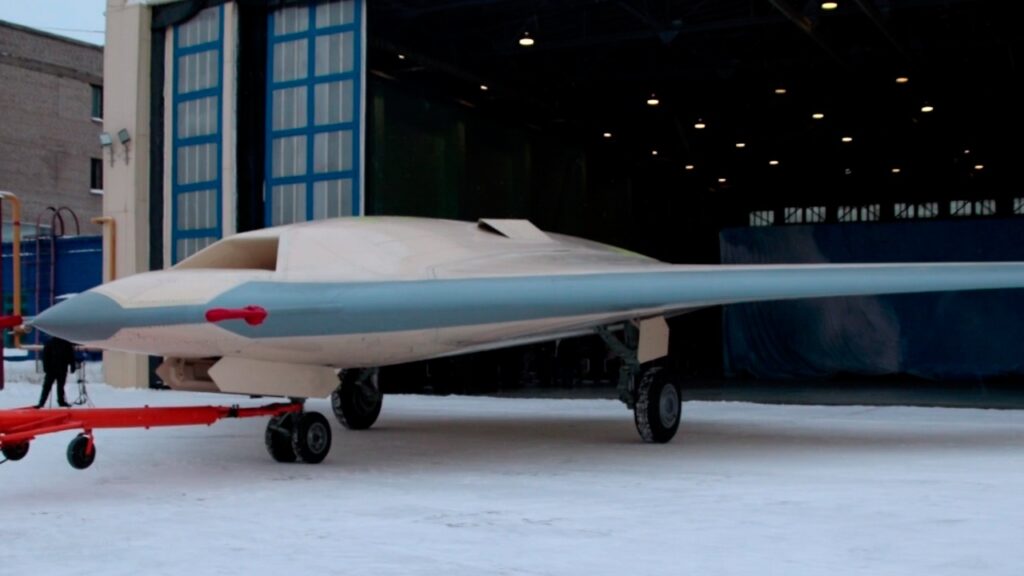Russia’s S-70 Okhotnik (Hunter) drone is expected to finish testing by the end of this year and go into production by the beginning of 2024, according to officials from the Russian Air Force (RuAF).
This assumes significance, as it comes with developments on the Su-57 fifth-generation fighter front, suggesting Russia is moving steadily towards operationalizing both platforms and fielding them in their manned-unmanned wingman role.
A TASS report quoted an unnamed senior official from the High Command of the Aerospace Forces of Russia, saying, “Existing plans (stipulate) the state tests of the Okhotnik should be completed before the end of this year.”
“From the beginning of 2024, mass production will be launched with delivery to the troops. The contract provides for the delivery of several dozen aircraft,” it added.
The news agency, however, clarified that it does not have official confirmation about the development. Nevertheless, certain inferences about progress on the program can still be drawn based on other reports and the general activity in Russia’s defense industrial sector.
S-70 Production & Fielding Progressing Steadily
Typically, updates on developing, testing, and producing defense platforms come from the Russian state-owned Joint Stock Holding (JSC) companies that have developed the product. In this case, it is the Sukhoi Design Bureau (SDB), United Aircraft Corporation (UAC) parent company, or the leading holding company Rostec Corporation.
The information from the RuAF (or Voenno-vozdushnye sily Rossii, VVS) means the senior official merely mentioned a schedule that the service has drawn up with the developer, which may or may or may not always be followed.
Russian defense industry and military officials are not known to make ambitious announcements or final statements about the acquisitions of advanced defense projects. However, that does not mean the report does not reliably reflect an essential stage in the project’s development since it has steadily achieved important milestones over the last two years.

A July 20 report in Aviaciaonline said a second drone prototype flew with a flatter exhaust nozzle instead of the previous round one. The new nozzle regulates the hot gas exhausts and reduces vulnerability to infrared detection and the plane’s rear radar signature. The same day also saw grainy footage claimed to be of the drone flying alongside another unidentified aircraft.
The drone was unveiled with the flat nozzle in December 2021, and the announcement was to enter serial production by 2023. Rostec CEO Sergei Chemezov gave the information to President Vladimir Putin. Chemezov added that a new ground control post was being developed for the drone, indicating the drone might begin reaching Russian Air Force (or Voenno-vozdushnye sily Rossii, VVS) units by 2024.
The experimental prototype made its first flight on August 3, 2019, which lasted more than 20 minutes. A 30-minute flight alongside the Su-57 fighter was reported a few months later. In December 2020, RIA Novosti said Okhotnik conducted simulated tests with infrared (IR) and radar-seeker air-to-air missiles to test the UCAV’s fire-control systems at the 185th Combat Application and Training Center at Ashuluk.
It conducted its first live-fire test by releasing unguided bombs on a target at the Ashuluk training ground near the Caspian Sea, according to a report in January 2021. On May 28, RIA Novosti reported a “series of guided missile firing” tests, which Janes Defense concluded was the Kh-59MK2 standoff cruise missile.
But on June 9 and July 27, developments involving the Su-57 indicated Russia was progressing rapidly towards possessing an operational manned-unmanned teaming capability.
Su-57, Too, Coming Up Fast!
This was followed by a June 9 RIA Novosti report that said four Su-57s were used in the ongoing Special Military Operation (SMO) in Ukraine in what appeared to be a Suppression of Enemy Air Defense (SEAD) operation.
The quartet was “linked to a single information network to destroy air defense systems through automatic communication systems, data transmission, navigation and identification in real-time. The low radar visibility of the Su-57 was also confirmed,” the article said.
Andrey Yelchaninov, Deputy Chairman of the Board of the Russian Military-Industrial Commission, later said in a separate interview that the planes and drones could interact “not only with each other but also in various types of combat formations.” On July 27, TASS reported that a two-seat variant of the Su-57 will be developed to control a swarm of Okhotnik combat drones “in network-centric interactions to strike aerial and ground targets.”
The June 9 operation indicates that it is unlikely the Su-57 will not be used for routine tactical missions, with the bulk of the air-to-air and air-to-ground missions being possibly carried out by the Su-30 and Su-35.
At least initially, its mission profile would involve taking out enemy fighters from beyond visual ranges with missiles like the Vympel R-77 and SEAD or Destruction of Enemy Air Defense (DEAD) operations.
Both Programs Coordinated
Okhotnik’s May 28 test reports said the platform could “effectively hit small-sized camouflaged targets with missiles at different times of the day.”
While there is no evidence of Su-57 being used in the SMO, if factual, it must have been conducted to freeze specific operational procedures and verify the performance of its components, like sensors and data linking/transmission and the Active Electronically Scanned Array (AESA) radar.
Also, Su-57s with a newer, second-stage engine, Izdeliye 30, would soon begin reaching VVS units following underway fight tests, a EurAsian Times analysis said. Thus, considering the parallel developments in both platforms, Russian defense industry planners have certainly coordinated the S-70’s and the Su-57’s production schedules.
Even considering delays, the first batch of S-70s from low-rate initial production models, most likely based on the second, third, or fourth prototypes, can be expected to reach the VVS by early to mid-2025. Russia is well on its way to becoming the first country to field the first operational loyal wingman team.
- The author can be reached at satamp@gmail.com
- Follow EurAsian Times on Google News